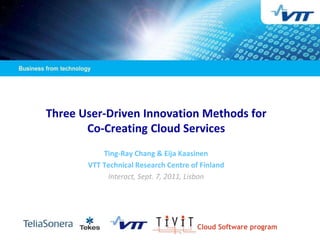
Three User-Driven Innovation Methods for Co-Creating Cloud Services
- 1. Three User-Driven Innovation Methods for Co-Creating Cloud Services Ting-Ray Chang & Eija Kaasinen VTT Technical Research Centre of Finland Interact, Sept. 7, 2011, Lisbon Cloud Software program
- 2. 08/09/2011 2 Agenda of the presentation Introduction: Cloud Services & Open Telco Motivations & some initial decisions Method one: Focus group ideation Method two: Online Crowdsourcing in Open Web Lab (Owela) Method three: Direct Interaction at the Open Innovation Showroom (Ihme) Examples of user ideations and acceptance comments toward privacy Q&A
- 3. 08/09/2011 3 Introduction: cloud services & Open Telco Cloud Software: installable applications web-based computing, somewhat a new idea for everyday end-users Open Telco: Open API framework for mobile networks, aim to develop services utilizing users’ data via tele-operators Creating value proposals within the project partners Expertise from the project group: technical, business, designers, researchers, etc. 9 value proposals Outcome illustrated initial scenarios Technical possibilities services users actually want
- 4. 08/09/2011 4 User Driven Innovation & Co-Creation User-Driven Innovation [Holmquist, L.(2004)] : Users considered as a source of inspiration that can foster innovation. Co-creation: With USERS, designers/researchers gain insights in idea generations to create services Co-design: User role is an equal design partner which enables the designers and users make design decisions together Participatory design: multi-stakeholders work together in different stages of design practices
- 5. 08/09/2011 5 Motivations & some initial decisions Cloud computing, what could it be for our end-users? To involve users in early design processes To gather different levels of insights from the end-users, from the values of the services to specific interactions and user experiences Different types of user-involvement: real-world versus lab setting, face-to-face versus online interaction, synchronized versus unsynchronized ideation Resource dependent Quantitative versus qualitative analysis in goal-oriented research
- 6. 08/09/2011 6 Focus group ideation Established user study method Goal: feedback on acceptance and ideation of proposed value proposals 8 participants, 4F+4M, invited and scheduled, user lab setting, one hour. Introduce value proposals with illustrated scenarios, comments and group discussions. Followed by group ideations of future TV Lists of ideas and comments were produced, many consensus were reached
- 7. 08/09/2011 7 Online Crowdsourcing in Open Web Lab (Owela) 84 Users from around the world invited to participate the online ideation Users ideated free from time and space restrictions Researcher participation for motivating and monitoring ideation and discussions Large amount of data (221 threaded comments), crazy ideas, deep feelings, and vivid stories More tech-oriented user groups
- 8. 08/09/2011 8 An example of user ideations of future TV
- 9. 08/09/2011 9 Direct Interaction at the Open Innovation Showroom (Ihme) Ihme: bring user research to the users’ world, in a living lab (in Finnish Ihme also means miracle) Other new technology to try and experience (e.g. eye-ware-free 3D-TV) Semi-structured discussions between researchers, designers and users 20 – 45 mins per session, 26 participants in first two weeks Users of all types could participate in & out freely, attracted “everyday” user groups Pro: Designers/researchers in users’ shoes, co-create tangible UX Challenge: recruit & motivate participation, flexible schedule
- 10. 08/09/2011 10 examples of user ideations of future TV and M2M
- 11. 08/09/2011 11 Some acceptance comments toward privacy in all studies @Focus group: ‘yes I think it can be a problem.’ ‘yeah I also worry.’ @Ihme: ‘It [peer recommendation services] feels like being tracked when you are on the road and everyone will make the same choices.’ ‘If it [universal profile] follows me everywhere, it is like a chip in my dog...’ @Owela: ‘there are going to be serious privacy issues though, so this would definitely need to be an opt-in service so people don’t get upset.’ ‘I think I would be a bit worried about who gets access to my information and possible misuse issues.’ ‘It seems obvious to me that this information cannot possibly be kept private. It already bugs me that my car can be tracked as I cross bridges or toll points.’
- 12. 08/09/2011 12 Comparisons of three studies Focus group Owela Ihme Length of the study 1 hour 1 month 3 weeks No. of users involved 8 participants 84 online users, 49 M + 35 F 26 users Procedure BriefingIdeation Briefing Briefing Ideation+Discussion Discussion Ideation+Discussion Study duration 1 hour 4 weeks 20~40 min per user, 3wks Value proposals 4 (4, 5 and 6, 7) 5 (1, 2, 3 and 6, 7) 5 (1, 2, 3 and 6, 7) Environment Laboratory Real world Real world Illustration material PowerPoint, video clips of Screen shots of scenarios PowerPoint, video clips of scenarios scenarios Media Face to face Online Face to face Data gathering Notes and post-its Online forum Interview notes & post-its No. of comments 63 221 252 Data from Scen. 1-3 Acceptance comments + 5 Acceptance comments + 20 Questionnaire data (19 questions) new* ideas new* ideas Different categories of 4 12 13 ideas – future TV Different categories of 5 12 5 ideas – M2M Group/individual Group Group Individual discussions User participation, Scheduled Free Free scheduled versus free
- 13. 08/09/2011 13 Take-away For our project: value proposals evaluated and further developed into cloud services, ex. Group text chat, “why? I already have it on my phone..” Deep understanding of the end-users Ideation and evaluation with lead users and everyday users For researchers and designers: Focus group was the most efficient method for producing quick ideas and feedback; Owela online co-creation gave most creative ideas; and Ihme direct interaction in a living lab creates the most close-to-real- life-experience (tangible) ideas. Other things to consider: resource, recruiting and motivating users
- 14. 08/09/2011 14 For further interests To find out more about User-driven innovation and TAMM (Technology Acceptance Model for Mobile Services), see: http://www.vtt.fi/people/eija_kaasinen.jsp?lang=en Cloud Software Program: http://www.cloudsoftwareprogram.org Further questions or to get the PPT from this presentation: Find ”Ting-Ray Chang” on LinkedIn, or (DesignResearcher) http://www.linkedin.com/in/designresearcher
- 15. 08/09/2011 15 VTT creates business from technology
